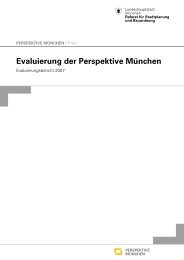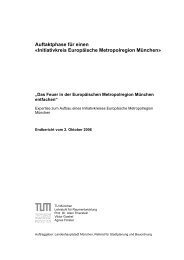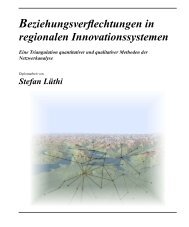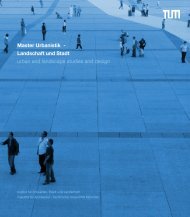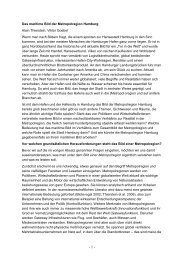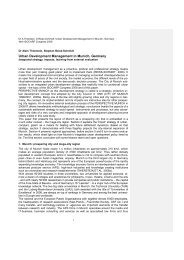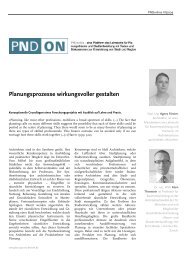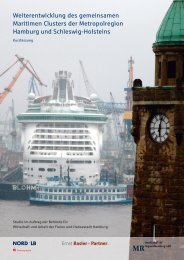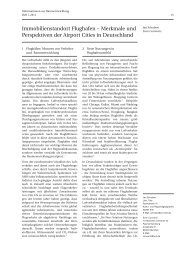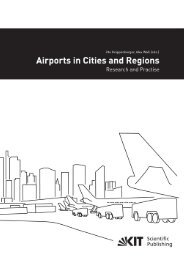0.6-1-Cover and Table of Contents-pp 0-05.indd - Raumentwicklung ...
0.6-1-Cover and Table of Contents-pp 0-05.indd - Raumentwicklung ...
0.6-1-Cover and Table of Contents-pp 0-05.indd - Raumentwicklung ...
Create successful ePaper yourself
Turn your PDF publications into a flip-book with our unique Google optimized e-Paper software.
MAHMOUD REZA SAGHAFI, JILL FRANZ, AND PHILIP CROWTHER<br />
Perceptions <strong>of</strong> Physical versus Virtual Design Studio Education<br />
Sit at the desk now <strong>and</strong> you do some work <strong>and</strong><br />
then show me before the end <strong>of</strong> the class. Being<br />
virtually, I can’t tell them; okay, do some stuff now<br />
<strong>and</strong> show me at the end <strong>of</strong> the class. In VDS, it<br />
does not work like that.<br />
For some students the decision to come to campus<br />
or study from home was determined by how much<br />
each world encroaches on their personal life. Some<br />
students prefer to design in the campus studio<br />
because they feel home to be too cramped.<br />
Alternatively, a studio could be helpful for some<br />
to generate an idea <strong>and</strong> obtain feedback then<br />
further develop the proposal at home.<br />
I would like to start <strong>of</strong>f with an idea in a studio, get<br />
some feedback <strong>and</strong> then play around with the<br />
idea in my own home <strong>and</strong> once I am ha<strong>pp</strong>y with<br />
it, I would like the o<strong>pp</strong>ortunity to discuss it more in<br />
the studio - but most <strong>of</strong> the designing I would like<br />
to do at home.<br />
Based on the description <strong>of</strong> design process by the<br />
participants; studio can provide an a<strong>pp</strong>ropriate<br />
space which helps students to find possible<br />
ideas <strong>and</strong> focus on their imaginations for their<br />
design projects. Since design courses involve<br />
imagination, a place plays an important role in<br />
inspiring students. In contrast when provided with<br />
contact time in class, some students come for<br />
five minutes, talk, <strong>and</strong> then disa<strong>pp</strong>ear. For many<br />
students, most <strong>of</strong> their design conceptualization<br />
<strong>and</strong> development ha<strong>pp</strong>ens outside the studio at<br />
home.<br />
9.Outcome<br />
Outcome refers to the learning aims which are<br />
assessed with knowledge gained through the<br />
process <strong>and</strong> the end-product <strong>of</strong> learning. Design<br />
studio outcomes are dependent on various<br />
design education parameters. According to the<br />
response <strong>of</strong> an educator in the questionnaire<br />
about factors involved in learning outcome.<br />
Many factors, like quality <strong>of</strong> learning outcome,<br />
depend on tutors’ functions. In the first case,<br />
delivering tacit knowledge even in PDS, depend<br />
on tutors’ functionalities. In the second one, it<br />
affect on feeling positively.<br />
Therefore, improving design studio elements<br />
leads to stronger outcome, while dull settings<br />
produce weaker projects. “The essence <strong>of</strong> the<br />
setting in terms <strong>of</strong> the physical design studio <strong>of</strong>ten<br />
seeps through the students design work - which<br />
is strength if the setting is good or problematic if<br />
it is dull”. Teaching a<strong>pp</strong>roach can strengthen the<br />
connection between theory, process <strong>of</strong> design<br />
<strong>and</strong> outcomes; <strong>and</strong> incorporating other tools such<br />
as different media to explore the design process<br />
in other ways improving learning outcomes.<br />
Discussion <strong>and</strong> Implications for a Blended<br />
Environment<br />
The previous section conveys several factors<br />
which impact on design studio education. Based<br />
on participants’ opinions, neither PDS nor VDS<br />
on their own can respond to all the needs <strong>and</strong><br />
preferences <strong>of</strong> students <strong>and</strong> tutors. Each mode<br />
<strong>of</strong> delivery has special qualities <strong>and</strong> learners<br />
have different learning styles that respond to<br />
these in different ways. Therefore, a combination<br />
<strong>of</strong> several media a<strong>pp</strong>ears to be a<strong>pp</strong>ropriate<br />
(Moore, 2006). This would tend to suggest the<br />
need for a blended design studio (BDS) model<br />
that optimises the benefits <strong>of</strong> both modes. The<br />
development <strong>of</strong> such a model however has to be<br />
considered in the context <strong>of</strong> particular universities<br />
<strong>and</strong> the infrastructure, policy <strong>and</strong> procedures that<br />
characterise that university. In this study increasing<br />
student numbers has placed considerable<br />
Archnet-IJAR, International Journal <strong>of</strong> Architectural Research - Volume 6 - Issue 1 - March 2012<br />
14



